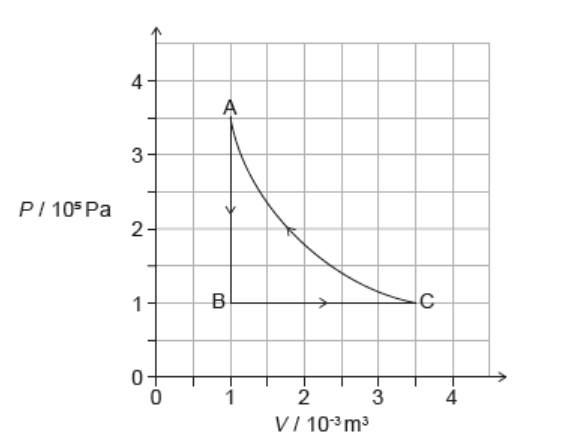Question
An ideal gas consisting of $0.300 \mathrm{~mol}$ undergoes a process $\mathrm{ABCD}$. $\mathrm{AB}$ is an adiabatic expansion from the initial volume $V_{\mathrm{A}}$ to the volume $1.5 V_{\mathrm{A}}$. $\mathrm{BC}$ is an isothermal compression. The pressures at $C$ and $D$ are the same as at $A$.

The following data are available.
$
\begin{aligned}
& \text { Pressure at } A=250 \mathrm{kPa} \\
& \text { Volume at } C=3.50 \times 10^{-3} \mathrm{~m}^3 \\
& \text { Volume at } D=2.00 \times 10^{-3} \mathrm{~m}^3
\end{aligned}
$
The gas at $\mathrm{C}$ is further compressed to $\mathrm{D}$ at a constant pressure. During this compression the temperature decreases by $150 \mathrm{~K}$.
For the compression CD,
a(i)Show that the pressure at $B$ is about $130 \mathrm{kPa}$.[2]
a(ii) Calculate the ratio $\frac{V_{\mathrm{A}}}{V_{\mathrm{C}}}$.
b(i)determine the thermal energy removed from the system.[3]
b(iiexplain why the entropy of the gas decreases.[2]
b(iiistate and explain whether the second law of thermodynamics is violated.[2]
▶️Answer/Explanation
Ans:
$
\begin{aligned}
& \mathrm{a}(\mathrm{i}) P_{\mathrm{B}}=\frac{250 \times 10^3}{1.5^{\frac{5}{3}}} \text { «from } P_{\mathrm{B}}\left(1.5 V_{\mathrm{A}}\right)^{\frac{5}{3}}=250 \times 10^3 \times V_{\mathrm{A}} \frac{5}{3} » \checkmark \\
& =127 \mathrm{kPa} \checkmark
\end{aligned}
$
$
\text { a(ii) }<127 \times 10^3 \times 1.5 V_{\mathrm{A}}=250 \times 10^3 V_{\mathrm{C}^{\prime}}
$
$1.31 \checkmark$
b(i)ALTERNATIVE 1
work done $\Delta W=\left\langle-» 250 \times 10^3 \times 1.5 \times 10^{-3}=\langle-» 375 \ll \mathrm{J} »\right.$
change in internal energy $\Delta U=\frac{3}{2} \times 0.300 \times 8.31 \times(-150)=《-» 561$ «J»
OR
$
\Delta U=\frac{3}{2} P \Delta V=\frac{3}{2} \times 375=\lll-» 563 « J »
$
thermal energy removed $\Delta Q=375+561=936$ $\varangle$ 》
OR
$
\Delta Q=375+563=938 \lll J \Downarrow \checkmark
$
ALTERNATIVE 2
$
\Delta Q=\left\langle n C p \Delta T=» \frac{5}{2} \times n R T \checkmark\right.
$
thermal energy removed $\Delta Q=0.300 \times 2.5 \times 8.31 \times 150$
$
=935 \text { 《J» }
$
b(ii)ALTERNATIVE 1
«from $\mathrm{b}(\mathrm{i}) » \Delta Q$ is negative
$\Delta S=\frac{\Delta Q}{T}$ AND $\Delta S$ is negative
ALTERNATIVE 2
$T$ and/or $V$ decreases
less disorder/more order «so $S$ decreases» $\checkmark$
ALTERNATIVE 3
$T$ decreases $\checkmark$
$
\Delta S=K \times \ln \left(\frac{T 2}{T 1}\right)<0
$
NOTE: Answer given, look for a valid reason that $S$ decreases.
b(iii).ot violated
the entropy of the surroundings must have increased
OR
the overall entropy of the system and the surroundings is the same or increased
Question
A heat pump is modelled by the cycle A→B→C→A.

The heat pump transfers thermal energy to the interior of a building during processes $C \rightarrow A$ and $A \rightarrow B$ and absorbs thermal energy from the environment during process $\mathrm{B} \rightarrow \mathrm{C}$. The working substance is an ideal gas.
a. Show that the work done on the gas for the isothermal process $\mathrm{C} \rightarrow \mathrm{A}$ is approximately $440 \mathrm{~J}$.[2]
bi. Calculate the change in internal energy of the gas for the process $A \rightarrow B$.[2]
bii. Calculate the temperature at $\mathrm{A}$ if the temperature at $\mathrm{B}$ is $-40^{\circ} \mathrm{C}$.[1]
c. Determine, using the first law of thermodynamics, the total thermal energy transferred to the building during the processes $C \rightarrow A$ and $A \rightarrow B$.[3]
d. Suggest why this cycle is not a suitable model for a working heat pump.[2]
▶️Answer/Explanation
Ans:
a. evidence of work done equals area between $\mathrm{AC}$ and the Volume axis $\checkmark$
reasonable method to estimate area giving a value 425 to $450 \mathrm{~J}$
Answer $440 \mathrm{~J}$ is given, check for valid working.
Examples of acceptable methods for MP2:
– estimates 17 to18 small squares $x 25 \mathrm{~J}$ per square $=425$ to $450 \mathrm{~J}$.
– $250 \mathrm{~J}$ for area below BC plus a triangle of dimensions $5 \times 3,3 \times 5$, or $4 \times 4$ small square edges giving $250 \mathrm{~J}+187.5 \mathrm{~J}$ or $250 \mathrm{~J}+200 \mathrm{~J}$.
Accurate integration value is $438 \mathrm{~J}$ – if method seen award [2].
bi. «use of $\mathrm{U}=\frac{3}{2} \mathrm{nRT}$ and $\mathrm{pV}=\mathrm{nRT}$ to give»
$
\begin{aligned}
& \Delta \mathrm{U}=\frac{3}{2} \Delta \mathrm{pV} \checkmark \\
& «=\frac{3}{2} \times-2.5 \times 10^5 \times 1 \times 10^{-3} » \\
& =«-» 375 « \mathrm{~J} » \checkmark
\end{aligned}
$
Another method is possible: eg realisation that $\Delta U$ for $B C$ has same magnitude, so $\Delta U=3 / 2 P \Delta V$.
bii. $T_{\mathrm{A}}=816 \ll \mathrm{K} \gg$ OR $543{ }^{\circ} \mathrm{C} »$
c. for $\mathrm{CA} \Delta U=0$ so $Q=W=-440 « \mathrm{~J} »$
for $\mathrm{AB} W=0$ so $Q=\Delta \mathrm{U}=-375$ «»
815 «J» transferred to the building
Must use the first law of thermodynamics for MP1 and MP2.
d. the temperature changes in the cycle are too large
the cycle takes too long «because it contains an isothermal stage» energy/power output would be too small